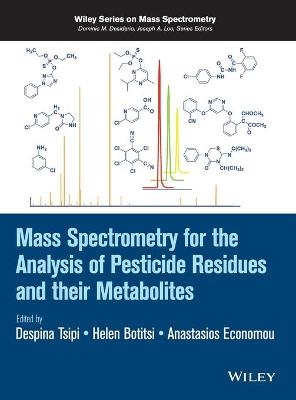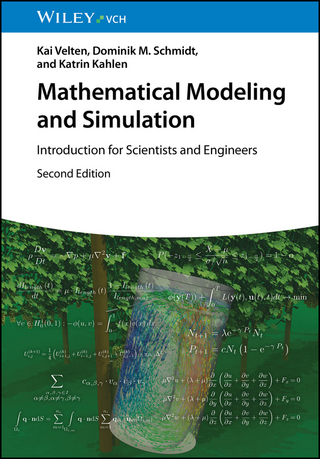
Mass Spectrometry for the Analysis of Pesticide Residues and their Metabolites
John Wiley & Sons Inc (Verlag)
978-1-118-50017-0 (ISBN)
- Lieferbar (Termin unbekannt)
- Versandkostenfrei innerhalb Deutschlands
- Auch auf Rechnung
- Verfügbarkeit in der Filiale vor Ort prüfen
- Artikel merken
Presents state of the-art MS techniques for the identification of pesticides and their transformation products in food and environment
Covers important advances in MS techniques including MS instrumentation and chromatographic separations (e.g. UPLC, HILIC, comprehensive GCxGC) and applications
Illustrates the main sample preparation techniques (SPE, QuEChERS, microextraction) used in combination with MS for the analysis of pesticides
Describes various established and new ionization techniques as well as the main MS platforms, software tools and mass spectral libraries
Despina Tsipi is the Director of Food Safety & Quality Laboratories (including the Pesticide Residues Laboratory) of the General Chemical State Laboratory, Athens, Greece. She holds a B.Sc. in Chemistry and a Ph.D in Photochemistry from the University of Athens, after a doctoral fellowship in NRSC Demokritos. She works in the field of pesticide residues analysis in foodstuffs and environment using hyphenated MS techniques for over 20 years. Between 2003-2006, she joined the Panel of Plant Protection Products and their Residues (PPR-Panel) of the European Food Safety Authority. She is a founding member and current president of the Hellenic Mass Spectrometry Society. Helen Botitsi is the Head of the Pesticide Residues Laboratory, a National Reference Laboratory of EU for pesticide residues analysis in foods of plant and animal origin of the General Chemical State Laboratory, Athens, Greece. She holds a B.Sc. in Chemistry and a Ph.D in Biochemistry from the University of Athens. Her main field of expertise is method development for pesticide and pharmaceutical residues analysis in foodstuffs and environmental samples using GC-MS and LC-MS techniques as well as method validation and quality control. Anastasios Economou is Associate Professor at the Laboratory of Analytical Chemistry, University of Athens, Greece. He holds a B.Sc. in Chemistry from the University of Athens, a M.Sc. and a Ph.D in Analytical Science and Chemical Instrumentation from the University of Manchester. His research interests are focused on the development of electrochemical, spectroscopic and chromatographic analytical methods as well as the development of automated analytical systems.
List of contributors xi
Foreword xiii
Preface xv
1 Pesticide Chemistry and Risk Assessment 1
Despina Tsipi, Helen Botitsi, and Anastasios Economou
1.1 Introduction 1
1.2 Pesticide Chemistry 2
1.2.1 Historical Perspective 2
1.2.2 Identity and Physicochemical Properties of Pesticides 2
1.2.3 Pesticide Classification 4
1.2.4 Modes of Action (MoA) 5
1.3 Pesticide Metabolites and Transformation Products 8
1.3.1 Biotransformation 9
1.3.2 Environmental Fate 13
1.4 Risk Assessment 14
1.4.1 Safety Factors 14
1.4.2 Ecological Risk Assessment for Pesticides 15
1.5 Dietary Exposure to Pesticides 17
1.5.1 Acute Exposure or Short‐Term Intake 18
1.5.2 Chronic Exposure or Long‐Term Intake 18
1.5.3 Cumulative Exposure to Multiple Substances 18
1.6 Pesticide Residues in Food 19
1.6.1 Maximum Residue Limits 19
1.6.2 Residue Definition 20
1.6.3 Reporting of Results 28
1.6.4 Residue Analysis 28
References 29
2 Legislation, Monitoring, and Analytical Quality Control for Pesticide Residues 35
Despina Tsipi, Helen Botitsi, and Anastasios Economou
2.1 Introduction 35
2.2 Food Safety 36
2.2.1 CAC of Food and Agriculture Organization/World Health Organization 36
2.2.2 EU Legislation 36
2.2.3 US Food Regulations 40
2.3 Water Quality 44
2.3.1 WHO 44
2.3.2 EU Water Framework Directive 44
2.3.3 US EPA Legislation 46
2.4 Method Validation and Quality Control Procedures for Pesticide Residues Analysis 46
2.4.1 CAC Guidelines 46
2.4.2 EU Guidelines: SANCO Document 47
2.4.3 FDA and EPA Guidelines 48
References 50
3 Advanced Sample Preparation Techniques for MS Analysis 53
Yolanda Picó
3.1 Introduction 53
3.2 Conventional Extraction and Cleanup Procedures 54
3.2.1 LLE 54
3.2.2 SPE 61
3.2.3 MSPD 63
3.2.4 QuEChERS 63
3.3 Microextraction Techniques 65
3.3.1 Sorbent‐Based Microextraction Techniques 65
3.3.2 Liquid‐Based Microextraction Techniques 71
3.4 Alternative Extraction and Cleanup Procedures 73
3.4.1 Alternative Energy Sources to Enhance the Extraction 73
3.4.2 Coupled‐Column Liquid Chromatography (LC/PC, LC/LC Techniques) 79
3.4.3 Direct Analysis in Real Time 80
3.5 Conclusions 81
References 82
4 Recent Developments in Gas Chromatography–Mass Spectrometry 91
Kaushik Banerjee and Sagar Utture
4.1 Introduction 91
4.2 Advances in GC Separations 91
4.2.1 Multidimensional and Comprehensive Two‐Dimensional Gas Chromatography 92
4.2.2 Fast GC 94
4.2.3 LPGC 95
4.3 Mass Spectrometric Ionization Techniques 96
4.3.1 Electron Impact Ionization (EI) 97
4.3.2 CI (Positive/Negative Modes) 97
4.3.3 Atmospheric Pressure GC–MS 98
4.4 Mass Analyzers Interfaced to GC 99
4.4.1 Quadrupole Mass Analyzer 100
4.4.2 Ion Trap Mass Analyzer 100
4.4.3 QqQ 100
4.4.4 TOF 102
4.5 Mass Spectral Libraries and Software Approaches in GC–MS Analysis 103
4.6 Matrix Effects in GC–MS Analysis 106
4.7 Conclusions and Perspectives 108
References 108
5 Recent Developments in Liquid Chromatography–Mass Spectrometry: Advances in Liquid Chromatographic Separations and Ionization Techniques/Interfaces 113
Alexandros G. Asimakopoulos, Anna Bletsou, Kurunthachalam Kannan, and Nikolaos S. Thomaidis
5.1 Introduction 113
5.2 Advances in Liquid Chromatographic Separations 114
5.2.1 Ultraperformance Liquid Chromatography 116
5.2.2 Hydrophilic Interaction Liquid Chromatography 117
5.3 Ionization Techniques/Interfaces 117
5.3.1 Atmospheric Pressure Ionization Techniques 118
5.3.2 Direct Electron Ionization 121
5.4 Ambient Ionization Techniques 122
5.4.1 DESI, Paper Spray, and Low‐Temperature Plasma Ambient Ionization 122
5.4.2 Direct Analysis in Real Time 124
5.4.3 Atmospheric Pressure Glow‐Discharge Ionization 125
5.5 Summary 125
References 125
6 Recent Developments in Liquid Chromatography–Mass Spectrometry: Mass Detectors 131
Silvia Lacorte, Ana Agüera, Montserrat Cortina‐Puig, and Cristian Gómez‐Canela
6.1 Introduction: Mass Spectrometers 131
6.1.1 Triple Quadrupole Mass Analyzer 132
6.1.2 Quadrupole Ion Trap and Triple Quadrupole Linear Ion Trap 135
6.1.3 TOF Mass Analyzer 138
6.1.4 Hybrid TOF 140
6.1.5 Orbitrap Mass Analyzer 142
6.2 Comparison and Complementarities of Different Mass Analyzers in the LC-MS Analysis of Pesticide Residues and their Metabolites 147
6.2.1 Dynamic Range 147
6.2.2 Scan Rate 147
6.2.3 LODs 148
6.2.4 Mass Accuracy 148
6.2.5 Resolution 149
6.2.6 Selectivity 149
6.2.7 Mass Range 150
6.2.8 Fragmentation 150
6.2.9 Identification Capabilities 150
6.2.10 Quantification 151
6.3 Use of Software Techniques and Spectral Libraries in LC–MS 152
References 154
7 Matrix Effects in Liquid Chromatography–Electrospray Ionization–Mass Spectrometry 161
Helen Stahnke and Lutz Alder
7.1 Introduction 161
7.1.1 Some Definitions 161
7.1.2 Differences between Matrix Effects in GC and LC Methods 162
7.1.3 Differences between ESI and Other API Methods 162
7.1.4 A Typical Alarming Situation 163
7.2 Detection of Matrix Effects 164
7.2.1 Calibration in Solvent versus Matrix‐Matched Calibration 164
7.2.2 Postcolumn Infusion 165
7.2.3 Stable Isotope-Labeled Standards 166
7.3 Reduction of Matrix Effects 166
7.3.1 Change of LC Conditions 166
7.3.2 Change of MS Conditions 166
7.3.3 Better Cleanup 169
7.3.4 Backflush of LC Columns 170
7.3.5 Dilute-and-Shoot 171
7.4 Compensation of Matrix Effects 172
7.4.1 Internal standards (IS) 172
7.4.2 Matrix‐Matched Standards 174
7.4.3 Postcolumn Infusion 174
7.4.4 Standard Addition 175
7.5 An Attempt to Explain Matrix Effects 176
7.5.1 Substance Classes Causing Matrix Effects 176
7.5.2 Tentative Mechanisms of Matrix Effects 176
7.5.3 A Recent View on the Mechanism of Ion Suppression 178
References 180
8 Liquid Chromatography–Mass Spectrometry Analysis of Pesticide Residues and Their Metabolites in Food Samples 187
Ana Lozano, Łukasz Rajski, María del Mar Gómez‐Ramos, Carmen Ferrer, Maria D. Hernando, and Amadeo R. Fernández‐Alba
8.1 Introduction 187
8.2 Application of LC–QqQ‐MS/MS for the Targeted Analysis of Pesticide Residues and their Metabolites in Food Samples 189
8.2.1 Sensitivity 192
8.2.2 Linearity 193
8.2.3 Matrix Effects 193
8.3 Application of LC–Hrms to the Analysis of Pesticide Residues and their Metabolites in Food Samples 195
8.3.1 Detection and Identification 195
8.3.2 Resolution 197
8.3.3 MS/MS Identification 200
8.3.4 Sensitivity 201
8.3.5 Linearity 201
8.3.6 Matrix Effect 202
8.4 Data Processing: Automated Database Searches 202
8.5 Conclusions and Future Developments 203
References 203
9 Application of LC–MS/MS and LC–TOF ‐MS for the Identification of Pesticide Residues and Their Metabolites in Environmental Samples 207
Imma Ferrer and E. Michael Thurman
9.1 Introduction and Occurrence of Pesticides in Environmental Samples 207
9.2 State‐of‐the‐Art Techniques for the Identification of Pesticides and their Degradation Products 208
9.2.1 LC–MS/MS for the Analysis of Target Compounds 208
9.2.2 LC–TOF‐MS and LC–QTOF‐MS for the Analysis of Target and Nontarget Compounds 209
9.3 Use of Accurate Mass Tools for the Identification of Pesticide Residues and their Metabolites in Food and Water Samples 215
9.3.1 Molecular Features 215
9.3.2 Accurate Mass Filters and Isotopic Mass Defect 220
9.3.3 Diagnostic Ion Approach 221
9.3.4 Accurate Mass Databases 223
9.3.5 Accurate Mass Profiling 225
9.4 Conclusions 227
References 227
10 Mass Spectrometric Techniques for the Determination of Pesticide Transformation Products Formed by Advanced Oxidation Processes 231
Ioannis K. Konstantinou
10.1 Introduction 231
10.2 Sample Preparation 232
10.3 Hyphenated MS Techniques 237
10.3.1 Low‐Resolution Mass Spectrometry: Single‐Stage Quadrupole 238
10.3.2 Identification of Pesticide TPs by GC–MS 238
10.3.3 Identification of Pesticide TPs by LC–MS 240
10.3.4 Identification of Pesticide TPs by the Combination of GC–MS and LC–MS 241
10.4 Tandem MS 241
10.4.1 Identification of Pesticide TPs by QqQ–MS 243
10.4.2 Identification of Pesticide TPs by IT–MS 244
10.5 HRMS 249
10.5.1 Single Mass Analyzer 249
10.5.2 Hybrid HR Mass Spectrometers 255
10.6 Conclusions and Perspectives 256
References 259
Index 263
| Erscheint lt. Verlag | 2.6.2015 |
|---|---|
| Reihe/Serie | Wiley-Interscience Series on Mass Spectrometry |
| Verlagsort | New York |
| Sprache | englisch |
| Maße | 213 x 279 mm |
| Gewicht | 1066 g |
| Themenwelt | Naturwissenschaften ► Chemie |
| Technik | |
| Weitere Fachgebiete ► Land- / Forstwirtschaft / Fischerei | |
| ISBN-10 | 1-118-50017-2 / 1118500172 |
| ISBN-13 | 978-1-118-50017-0 / 9781118500170 |
| Zustand | Neuware |
| Informationen gemäß Produktsicherheitsverordnung (GPSR) | |
| Haben Sie eine Frage zum Produkt? |
aus dem Bereich


